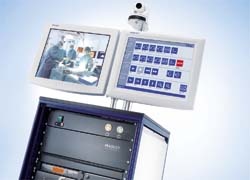Telemedicine for operating theatres
In Genk, Belgium, the Ziekenhuis Oost Limburg hospital simplified surgical workflow by installing a telemedicine system in a newly constructed interdisciplinary surgical wing. Dr Hubert Van der Put, Medical Director of ZOL, recalls its initiation and subsequent success.. In all major projects with lots of participants, success comes from timely planning between every department and company involved

For some years, surgeon Dr Kurt Vanderspeeten and ZOL’s IT manager Philip Verheye had hoped to install a visual system to support operating theatre workflow, provide access to patient data in a standardised format throughout the hospital, and automatically document and archive data. However, up to 2004, this was a major technical and financial challenge due to the different formats of imaging devices and other data sources. ‘Although there had been suggestions about using one solution or another, none of the known solutions were convincing for our individual and complex needs,’ Philip Verheye explained.
However, when planning began for a new, 14-ward interdisciplinary surgical wing at the Sint-Jan campus, a working party of members of the medical, IT, finance and administration departments was formed to discuss initial requirements for a central amalgamation of all patient data and imaging results. The main focus was on hospital-wide data availability and documentation. To attain the best possible investment protection, they favoured open, standardised hardware/software interfaces.
From a shortlist of telemedicine providers, Maquet won the tender to supply a universally deployable system, having taken into account the best-possible investment protection with a view to the short-term amortisation of the system and the avoidance of later amendments. Significance was attached above all to the system being universally deployable, regardless of manufacturers or a specific discipline.
Every 8-12 weeks during the 21/2-year project, the working party met with involved companies, e.g. Olympus (endoscopy), Zeiss (microscopy) and MEDA (anaesthesia), to discuss the incorporation of data migration and interfacing with the existing IT. Problem-free access to the Siemens PACS had to be guaranteed, as did local high definition visualisation in the operating theatre. The HIS developed by ZOL was not affected; maintenance/repairs would be carried out by the hospital’s software development department.
From a surgical perspective the deployment of the system was to provide the operating theatre team with the best-possible visual support. ‘To evaluate a situation we need all the available patient data as the basis for further steps. The possibility to view all of a patient’s data immediately saves us lots of time during surgery, because we no longer have to wait for this to be de-archived once a request has been submitted,’ said Dr Constantinus Politis, Head of the Oral and Maxillo-Facial Surgery Department. ‘At the same time, the operation of the system has to be simple and intuitive for the surgeons and the theatre team.’
Today, each theatre has at least one high-resolution wall monitor and a flat screen attached to the ceiling unit. Using a touch-screen the individual image sources can be transferred to individual monitors. The system automatically collects patient data from the theatre planning and management tool and clearly allocates each still image or video made during a surgical procedure. For teaching purposes live video images may be broadcast from the theatre over the local IT network to the auditorium.
Discussions within the working party ensured that any changes in their needs, or in technology, would be taken into account in the planning. For example, it was possible to amend the interface and cabling to new HD (high definition) technology for manufacturers’ endoscopic camera systems. Analogue camera systems and digital HD systems can be installed in the future without technical changes.
Real-time data exchange
Whereas DVDs were originally planned as data carriers, the disadvantages associated with this format soon became clear. The lack of fully automatic patient allocation and the administration of an ever-increasing media archive would have meant a considerably increased workload for medical personnel. Instead the DICOM format — already tested in radiology — was used. Its added value lies in clear automatic patient allocation and that the existing image viewing solution may also be utilised for theatre imaging. There are no additional costs for the purchase of proprietary archiving and viewing software or for personnel training.
Two electromagnetically shielded theatres proved a challenge for electronic installations. This was resolved by Maquet, which developed and implemented solutions to avoid unwanted electrical fields created by the video line and data cable. In 2006 came the simultaneous, successful launch of the surgical wing and telemedicine system.
The regular exchange of information and the excellent cooperation between all the project participants played a special role in that success, Maquet points out: ‘Thanks to the intensive preparation phase with the specialist departments at ZOL and the companies taking part in the project it was possible to avoid all the relevant problems in the implementation. Everyday problems, such as a potential difference of 80 volts between the monitor frame and the floor caused by the wrong cabling on a grounding strip, were quickly identified and rectified through close co-operation between the companies involved. With the choice of a telemedicine provider that exclusively specialises in system solutions for the OR, and also has extensive experience in communications electronics, it was possible to verify additional potential for savings.’
What could have been done better? ‘Even more timely planning with all the departments and companies involved, which could have further minimised the communication problems inevitably associated with major projects with a large number of participants.’
30.04.2008





